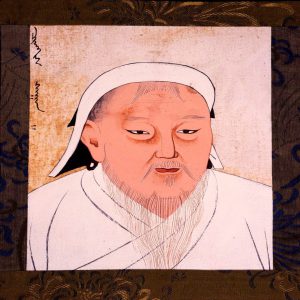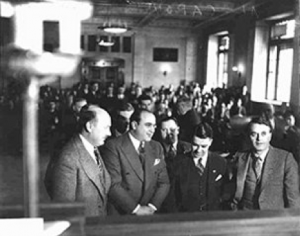What happens if the doctor in charge of your life decides to play God? What happens if the doctor decided to end it? On September 7, 1998, Dr. Harold Shipman was arrested for the murder of Kathleen Grundy. October 5, 1999, his trial began at Preston Crown Court and he was accused of killing fifteen elderly patients. On January 31, 2000, he was sentenced to life in prison for all fifteen counts of murder.1 But this is only the end of Shipman’s career. How does someone become this kind of killer? Was there always this desire lurking within him? Or is this the path that was shaped by his past? This begins the becoming of Dr. Death.
Harold Shipman was born as the middle child into a working-class family on January 14, 1946. He was born from his father, Harold Frederick Shipman, who was a truck driver and his mother Vera Brittan.2 Both of his parents were devout Methodists. Harold would become the favorite child of his domineering mother, which allowed her to instill a sense of superiority in him. This would taint most of his later relationships, leaving him an isolated adolescent with few friends, despite being an accomplished rugby player in youth leagues. However, Shipman’s life would be forever altered at the age of seventeen, when his mother was diagnosed with terminal lung cancer.3 He would willingly look over her well being and would later become fascinated by the observations he made about the effect that the administration of morphine had on his mother’s suffering. She would pass away on June 21, 1963, and devastated by his loss, Shipman would decide to go to medical school. Shipman received a scholarship to medical school and was admitted to Leeds University Medical School after having failed his entrance exams, before serving his hospital internship. On November 5, 1966, at the age of nineteen, he would marry a farmer’s daughter, Primrose May Oxtoby, when she was seventeen and five months pregnant with their first child. Shipman graduated from Leeds University in 1970.4 Then he would begin working at Pontefract General Infirmary in Pontefract, West Riding of Yorkshire. Then in 1974, as a father of two, he took his first position as a general practitioner at the Abraham Ormerod Medical Centre in Todmorden. Initially, Shipman thrived. However, this changed when he developed an addiction to the painkiller Pethidine.
Pethidine (meperidine) is a narcotic that can be used for moderate to severe pain. It was first described by German chemist Otto Eisleb and Austrian pharmacologist Otto Schaumann in 1939 as being a compound derived from a series of potential atropine-like spasmolytic compounds, but having morphine-like analgesic activity.5 Atropine is an involuntary nervous system blocker, and spasmolytic is a drug or treatment that can relieve spasm of smooth muscle.6 Analgesic activity indicates the acting of pain relief.7 Addiction is described as a complex condition that often results in an emotional and physical dependence on the drug, even when met head-on with harmful consequences. Sections of the brain and spinal cord contain cells that have opiate receptors, structures that normally bind to the body’s natural painkilling chemicals. When the natural chemicals bind to the receptors, the pain signals that travel to the brain are diminished. Because the structures of the natural chemicals are very similar, it allows the narcotics to bind to cells’ receptors for natural painkillers. However, the pleasures of narcotics are quickly short. After a short amount of time, a user finds that the small dose that originally produced the effect is no longer effective. This occurs because the presence of narcotics in the brain causes it to stop using its built-in pain-blocking mechanisms, causing the drug to lose some of its effectiveness. As a result, the user needs increasingly larger doses of narcotics to experience the same feeling as before. This condition is called habituation or tolerance. Those who are addicted to narcotics and many other drugs suffer long-term health problems. Users tend to lose appetite, suffer long-term constipation, scarred or collapsed veins, infections of blood vessels and the skin, and hypoxia. Since opiates cause slow, shallow breathing, addicts do not take in enough oxygen to maintain normal levels in their blood. In the brain, lack of adequate oxygen can cause irreversible damage to neurons.8
After being caught forging prescriptions of pethidine, Shipman was fined £600 and briefly attended a drug rehabilitation clinic in York. He became a general practitioner at the Donneybrook Medical Centre in Hyde near Manchester, in 1977.9 He masked himself as a hardworking doctor, who enjoyed the trust of patients, although he had a reputation for arrogance among junior staff. He continued working as a general practitioner throughout the 1980s, and began his surgery in 1993, and became a respected member of the community.10 In 1983, he was interviewed on the Granada television documentary World in Action on how the mentally ill should be treated in the community. A year after his conviction, the interview was re-broadcast on Tonight with Trevor McDonald. However, in March 1998, Linda Reynolds of the Donneybrook Surgery, prompted by Deborah Massey from Frank Massey and Sons’ Funeral Parlour, expressed concerns to John Pollard, the coroner for the South Manchester District, about the high number of deaths among Shipman’s patients. The most concerning was a large number of cremation forms for elderly women that Shipman had needed to be countersigned. The matter was brought to the police. However, they weren’t able to find sufficient evidence to press charges; the police were later blamed for assigning inexperienced officers to the case. On April 7, 1998, the police abandoned the investigation. How did he get away this time?11 By his method of administering lethal doses of diamorphine (pharmaceutical heroin) into his unknowing victims.

Forensic toxicology is defined as the application of toxicology for the law. Toxicology is a branch of science that surrounds the nature, effects, and detection of poisons. Toxicologic investigations are important in cases such as homicides, where many deaths are drug-related.12 Many of Shipman’s victims’ bodies were cremated. However, they were able to exhume twelve victims. Analysis of the skeletal muscle disclosed that there were significant quantities of morphine, to which the deaths were attributed.13 Julie Evans, the forensic scientist who analyzed the levels of morphine found in some of the victims’ bodies, submitted evidence to the court. A substantial amount of the drug was found in samples taken from the thigh and liver of Kathleen Grundy. Other samples were taken from the bodies of other victims Bianka Pomfret, Winifred Mellor, Joan Melia, Ivy Lomas, Marie Quinn, Irene Turner, Jean Lilley, and Muriel Grimshaw, all of whom also revealed morphine.

Shipman, however, wouldn’t get away with it forever. His last victim was Kathleen Grundy, a former ceremonial Mayor of Hyde and active wealthy 81-year-old widow, who was found dead at her home on June 24, 1998. Shipman was the last person to see her alive and later signed her death certificate. Grundy’s daughter, lawyer Angela Woodruff, became concerned when solicitor Brian Burgess informed her that a will had been made, apparently by her mother. The will excluded Woodruff and her children but left £386,000 to Shipman.14 At Burgess’s urging, Woodruff went to the police, who began an investigation. Grundy’s body was exhumed and examined, was found to contain traces of diamorphine. Shipman claimed that she was an addict, and showed them comments he had written to that effect in his computerized medical journal; however, an examination of his computer showed that they were written after her death. Shipman was arrested on September 7, 1998, and was found to own a typewriter of the kind used to make the forged will.15 Other deaths Shipman had certified were then investigated by the police. They discovered a pattern of his administering lethal doses of diamorphine, signing patients’ death certificates, and then falsifying medical records to indicate that they had been in poor health. Shipman’s trial presided over by Justice Forbes, began on October 5, 1999. Shipman was charged with the murders of Marie West, Irene Turner, Lizzie Adams, Jean Lilley, Ivy Lomas, Muriel Grimshaw, Marie Quinn, Kathleen Wagstaff, Bianka Pomfret, Norah Nuttall, Pamela Hillier, Maureen Ward, Winifred Mellor, Joan Melia, and Kathleen Grundy, all of whom had died between 1995 and 1998.16 On January 31, 2000, after six days of deliberation, the jury found Shipman guilty of killing fifteen patients by lethal injections of diamorphine and forging the will of Kathleen Grundy. The trial judge sentenced him to fifteen consecutive life sentences and recommended that he never be released.

The Shipman Inquiry was the report produced by a British governmental investigation into Shipman. The inquiry released its findings in various stages, with its sixth and final report being released on January 27, 2005. It was chaired by Dame Janet Smith DBE.17 While Shipman was convicted of fifteen murders, the inquiry in July 2002 established that he had killed at least 215 people, and may have killed as many as 260, or even more. The inquiry took approximately 2,500 witness statements and analyzed approximately 270,000 pages of evidence. In total, the six reports ran to 5,000 pages and the investigation cost £21 million.18
Shipman’s life ended when he hung himself in his cell at Wakefield Prison on January 13, 2004, on the eve of his 58th birthday.19 A Prison Service statement indicated that Shipman had hanged himself from the window bars of his cell using bed sheets. Today the number of lives that Shipman took from this earth is still unknown. However, we remember the names of the fifteen known victims. Marie West, Irene Turner, Lizzie Adams, Jean Lilley, Ivy Lomas, Muriel Grimshaw, Marie Quinn, Laura Kathleen Wagstaff, Bianka Pomfret, Norah Nuttall, Pamela Marguerite Hillier, Maureen Alice Ward, Winifred Mellor, Joan May Melia, and Kathleen Grundy.
- Alec Samuels, “Doctor Harold Shipman,” Medico-Legal Journal 68, no. 2 (2000): 37. ↵
- Robert M. Kaplan, Medical Murder : Disturbing Cases of Doctors Who Kill (Crows Nest: Allen & Unwin, 2009), 84. ↵
- Robert M. Kaplan, Medical Murder : Disturbing Cases of Doctors Who Kill (Crows Nest: Allen & Unwin, 2009), 84. ↵
- Trevor Jackson and Richard Smith, “Harold Shipman,” British Medical Journal 328, no. 7433 (2004): 231. ↵
- Laurence E. Mather and Peter J. Meffin, “Clinical Pharmacokinetics Pethidine,” Clinical Pharmacokinetics 3, no. 5 (1978): 352, https://doi.org/10.2165/00003088-197803050-00002 ↵
- Neville McBrien, Moghaddam, Reeder “Atropine Reduces Experimental Myopia and Eye Enlargement via a Nonaccommodative Mechanism,” Investigative Ophthalmology & Visual Science 34, no. 1 (2015): 205. ↵
- Kyoichi Shimomura, “Analgesic Effect of Morphine Glucuronides.” The Tohoku Journal of Experimental Medicine 105, no. 1, (1971): 47, https://doi.org/10.1620/tjem.105.45 ↵
- Drug Education Library, 2003, s.v. “Narcotic Addiction and Abuse.” ↵
- Richard Baker, “Implications of Harold Shipman for General Practice,” Postgraduate Medical Journal 80 (2004): 305. ↵
- Alec Samuels, “Doctor Harold Shipman,” Medico-Legal Journal 68, no. 2 (2000): 37. ↵
- Dame Janet Smith, The Shipman Inquiry (London: The Stationery Office, 2002-2005), 108. ↵
- Barry Levine, Principles of Forensic Toxicology (United States: AACC Press, 2003), 3-4. ↵
- Derrick Pounder, “The Case of Dr. Shipman.” American Journal of Forensic Medicine and Pathology 24 (2003): 219. ↵
- Owen Dyer, “Shipman murdered more than 200 patients, inquiry finds,” BMJ (Clinical research ed.) 325, no. 7357 (2002): 181, doi:10.1136/bmj.325.7357.181/a ↵
- Maxine Frith, GMC strikes Shipman off medical register (London: The Independent, 2000) ↵
- Michael Kennedy, “Dr Shipman, Murder and Forensic Toxicology,” Australian Journal of Forensic Sciences 41, no. 1 (2009): 3-6, https://doi.org/10.1080/00450610902936005. ↵
- Owen Dyer, “Shipman murdered more than 200 patients, inquiry finds,” BMJ (Clinical research ed.) 325, no. 7357 (2002): 181, doi:10.1136/bmj.325.7357.181/a ↵
- Dame Janet Smith, The Shipman Inquiry (London: The Stationery Office, 2002-2005), 5. ↵
- Robert M. Kaplan, Medical Murder : Disturbing Cases of Doctors Who Kill (Crows Nest: Allen & Unwin, 2009), 84. ↵



52 comments
Guadalupe Altamira
This article was very interesting and shocking. You can tell from the writing of this article that Shipman was experiencing a terrible trauma that was passed down to him. It left him to do more awful actions to others that will affect them till they lay to rest. It’s terrible to hear about what happened to the people he harmed. Overall a very good article and looking forward to reading more
Maria Luevano
It was very interesting and shocking to learn about the trauma that Shipman experienced in his early childhood. It is a great example of how people who experience any traumas will certainly follow into adulthood and will affect them for the rest of their lives no matter how old. This was a super interesting article and worth the read! Great job, Kathryn!
Jacob Galan
Very well written article about a case like this. It explains to us the reader what some of these forensic fields are like forensic toxicology and what some of the drugs are that he used. People like this have always left a little fear of hospitals since I don’t know what is going on in that person’s head and are they really going to take care of me.
Maria Jose Haile
The article was very well-written and captivating as someone who did not know any about the subject I feel like I understand the topic and I could summarize it if I was asked to do. I find it interesting how he was the middle child and ended up like this. I wonder if there was a time in his life in which he wanted to go back and change who he become. I also wonder if there was a stepping stone to becoming the man he ended up to become which ended up being leaving himself guilt free.
Celeste Loera
Great article! It is so crazy though how his childhood and his mother’s death lead him down this path of life. I still wonder how he was able to become a doctor given his past and how he was never caught after all his victims died a similar death. It is still so sad how his victims came to him for help but instead he cut their life short.
Faith Chapman
It seems to me that Shipman was trying to cope with the death of his mother by re-enacting her death with other people of similar age (although I don’t know how old Shipman’s mother was when she passed away, so I can’t say for sure) and gender, and with morphine since this was the drug he took notice of first. Of course, it’s great that he was put behind bars before he could kill more; he killed 15 people in three years alone, seemingly when he was 51-54 years old—if he hadn’t been arrested, his confirmed kills could have easily reach 100 by now, assuming he would still be practicing as a doctor.
Andrea Laguna
Very captivating! It is so infuriating how he was able to kill all that amount of people without being caught. It is even more maddening that people trust doctors to save their life and he was doing the opposite. As a doctor, you make an oath to help people, not harm them. His childhood loss is not an excuse for his actions. At least justice was made.
Hailey Lechuga
It is intriguing (although upsetting and saddening at most times) to observe the lives of people that commit heinous crimes, in which many involve a traumatic upbringing that is bound to have a huge impact on psychological well-being. However, one would never like to suspect a doctor being the perpetrator. It was extremely frightening to consider the fact that someone who has devoted their life to learning how to relieve people of pain have really done so just to purposely inflict more suffering.
Victor Rodriguez
There are many people that experience trauma and disastrous experiences during their early childhood of their lives. It is our duty as a society to help and support them. Shipman’s experiences during his childhood left him a scar and wound in his soul he was not able to recover from. He took that pain out by harming others and torturing innocent victims in order to release that tension that shadowed his soul and that pain that crushed his heart. It is very sad to see that Shipman took this path and decided to bring pain to others. However, justice made him pay for his actions.
Maria Cossio
Thank you Kathryn for the interesting article. It is truly awful to see how a doctor wants and can play God onto someone’s life. Doctors are there to help you overcome your illness or anything that might have happened to your body, not decide whether you live or lie. Truly it is good that he was caught and justice was served. However, not after this person killed several people and not knowing if he killed many more makes you wonder to investigate further or let it be.